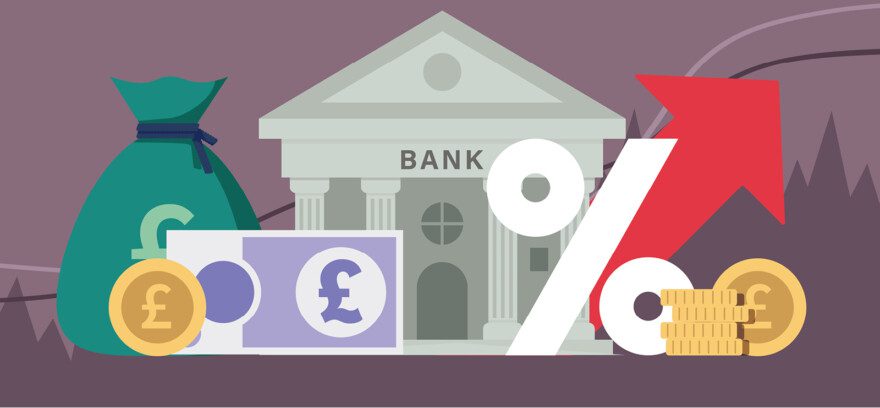UK markets were little changed this week, with the FTSE 100 Index falling 0.12% to trade at 8,255 points at the time of writing. The UK economy grew by 0.4% in May, double the figure expected, driven by continued expansion in the services sector and a rebound in housebuilding.
The rise in May followed zero growth in April and exceeded a 0.2% forecast by economists polled by Reuters. Sterling rose against the dollar to $1.293, its highest in almost a year, boosted by UK GDP numbers and lower than expected US inflation data. The strong growth in May suggests the quarterly expansion might exceed the Bank of England’s forecasts, potentially complicating its decision on whether to start cutting interest rates in August from their 16-year high of 5.25%. Investors are now evenly split on the likelihood of a Bank of England rate cut next month.
Earlier this week, they had been pricing in a two thirds likelihood, before Bank of England Chief Economist Huw Pill suggested that he was not yet ready to change his vote in favour of a rate cut. Sterling’s strength comes in the first week of a new Labour government, which investors have welcomed over hopes of a new era of relative political stability.
Elsewhere, UK retail sales fell in June as cold weather deterred shoppers from buying summer clothing and gardening supplies, despite pressure easing on households amid a slowdown in inflation. Figures from the British Retail Consortium showed a 0.2% drop in total UK retail sales compared with June last year. The gloomy consumer outlook comes as higher interest rates continue to weigh on household spending power.
While inflation has returned to the 2% target set by the government, prices still remain significantly higher than before the cost of living crisis took hold. The British Retail Consortium added that it expected retail sales to bounce back over the coming months, helped by the Euro 2024 tournament.
Commodity markets
In the commodity markets, Brent crude futures traded around $86 per barrel on Friday and are set for a slight decline this week, following four weeks of gains. Oil prices began to rise towards the end of the week as investor confidence was boosted after data on Thursday showed US consumer prices fell in June, raising hopes that the Federal Reserve will cut interest rates soon. Lower rates are expected to boost economic growth which would help raise fuel consumption.
However, the market is still awaiting clearer signs of action. Indications of strong summer fuel demand in the US also sustained prices. US gasoline demand was at 9.4 million barrels per day in the week ended July 5th, the highest since 2019, government data showed on Wednesday.
Jet fuel demand on a four week average basis was at its strongest since January 2020. The strong fuel demand encouraged US refiners to ramp up activity and draw from crude oil stockpiles. US Gulf Coast refiners’ net input of crude rose last week to more than 9.4 million barrels per day for the first time since January 2019, government data showed.
Gold Prices traded around $2,410 an ounce on Friday, and are set for a weekly rise, helped by a weaker dollar as cooler than expected US inflation data boosted hopes of the Federal Reserve cutting interest rates in September. Lower interest rates reduce the opportunity cost of holding non-yielding bullion.
Equity markets
US equity futures rose on Friday, after the S&P 500 and Nasdaq Composite suffered their worst day since April, amid a selloff in megacap technology stocks. In Thursday’s regular session, the Dow Jones Industrial Average rose 0.08%, the S&P 500 fell 0.88%, while the Nasdaq Composite plummeted 1.95%. US consumer price inflation fell to 3% in June, down from May’s rate of 3.3% and was lower than economists’ expectations compiled by Bloomberg of 3.1%. Treasury yields dropped as investors increased their bets on two interest rate cuts this year and President Joe Biden said the figures showed the US was “making significant progress fighting inflation”.
According to data from the London Stock Exchange Group, the odds of a September US interest rate cut rose to 96% in the immediate aftermath of the CPI data, compared with 72% beforehand. The inflation figures come as the Federal Reserve looks for further evidence that price pressures are easing in the world’s largest economy.
In a written testimony to the US Congress released on Tuesday, US Federal Reserve chair Jerome Powell said the central bank had made “considerable progress” in its mission to beat back inflation but sought “more good data” before cutting interest rates from their 23 year high. Recent inflation reports, one of which showed the Federal Reserve’s preferred gauge dropping to 2.6% in May have been encouraging.
However, Powel said that more positive data would strengthen confidence that inflation is moving sustainably towards 2%. Recent signs of a cooling in the labour market have also bolstered expectations for a fall in borrowing costs after the summer. The unemployment rate now sits at 4.1%, a level last registered in November 2021. Federal Reserve officials recently emphasised that a sudden weakening of the labour market could push the central bank to lower rates.
The information provided in this communication is not advice or a personal recommendation, and you should not make any investment decisions on the basis of it. If you are unsure of whether an investment is right for you, please seek advice. If you choose to invest, your capital may be at risk and the value of an investment may fall as well as rise in value, so you could get back less than you originally invested.
